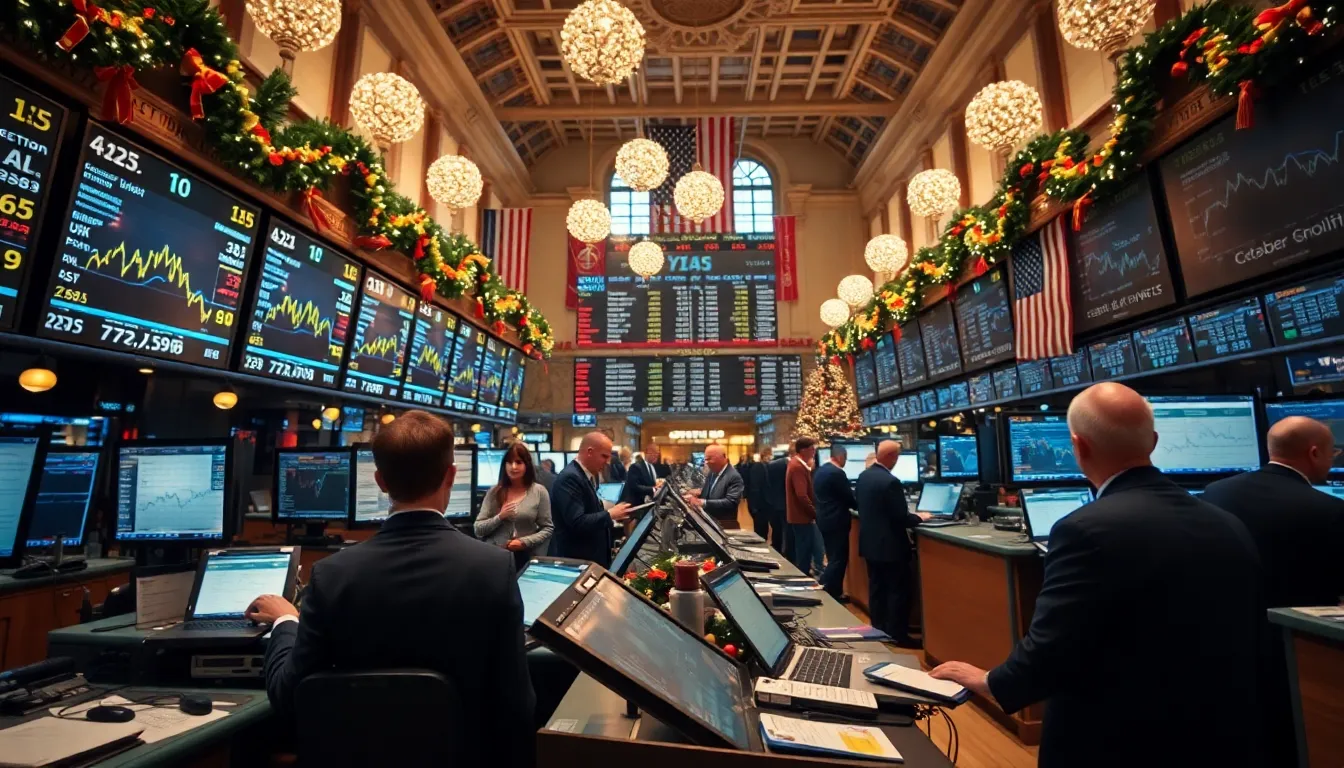Table of Contents
ToggleAs the clock ticks down to midnight on New Year’s Eve, many folks are busy planning their celebrations, but savvy investors know there’s another countdown happening: the stock market’s year-end wrap-up. While others are toasting with champagne, they’re crunching numbers and analyzing trends. After all, who needs confetti when you’ve got dividends?
Overview of Stock Market New Year Eve
Stock market activities on New Year’s Eve differ significantly from traditional celebrations. Investors scrutinize market performance, assessing trends to make informed decisions for the upcoming year. Earnings reports, economic indicators, and global developments become focal points as they prepare for the year-end close.
Traders often position themselves strategically, speculating on stocks that may reflect significant gains in January. Some investors take a cautious approach, opting to liquidate positions in underperforming assets to avoid carrying losses into the new year. Major indices, such as the S&P 500 and Nasdaq, often experience increased volatility during this time due to year-end adjustments.
Historical data shows notable trends, as the final days of December frequently determine market sentiment heading into January. Observing previous years, rallies and downturns toward year-end can set the tone for fresh starts. Many analysts recommend reviewing portfolios at this time, identifying high-performing equities and sectors for potential investment opportunities.
Market liquidity often decreases as many traders exit positions or engage in holiday festivities. Public sentiment, influenced by anticipation for the new year, can impact trading behavior. The interplay between celebratory anticipation and the stock market’s concrete numbers creates a unique atmosphere; it’s a blend of excitement for personal celebrations and financial foresight.
Essentially, while the world celebrates midnight, investors remain focused on making data-driven decisions, striving for financial growth in the new year. The contrast between traditional festivities and analytical approaches underscores the complexity of market dynamics during this season.
Historical Trends and Patterns

Investors monitor historical trends and patterns on New Year’s Eve to understand market behavior. Notable stock performances and economic factors play crucial roles in shaping these trends.
Notable Stock Market Performances
Historically, the stock market exhibits distinctive patterns during the last trading days of December. The S&P 500 and Dow Jones Industrial Average often demonstrate positive trends, boosting investor confidence. For instance, the “Santa Claus Rally,” which usually occurs in the last week of December, shows an average gain of approximately 1.3% in the S&P 500. Such patterns indicate a surge in investor optimism, often leading to upward momentum that carries into January. Traders frequently analyze these performances to strategize positions for the upcoming year, focusing on stocks that historically perform well in January.
Economic Factors Influencing Trends
Economic factors can significantly influence stock market trends during New Year’s Eve. Key indicators, such as employment rates, consumer confidence, and inflation data, impact overall market sentiment. For example, an increase in consumer spending near the end of the year can project a positive outlook for companies in retail. Analysts closely follow reports released around this time, as they provide valuable insight into potential market performance. Additionally, global events, such as geopolitical developments and changes in trade agreements, shape investor behavior. Understanding these economic contexts enables traders to make informed decisions as the calendar turns.
Investor Sentiment and Behavior
As New Year’s Eve approaches, investor sentiment often highlights optimism based on market patterns and trends. With historical data like the “Santa Claus Rally,” the S&P 500 typically shows an average gain of 1.3%. Analysts use such insights to formulate predictions about the forthcoming year. Confidence remains high for investors anticipating upward trajectories from strong economic indicators, employment rates, and consumer spending behaviors.
Market Predictions for Upcoming Year
Predictions for the new year reflect careful analysis of year-end market behaviors. Analysts focus on trends established in December, which often set the tone for January. Increased consumer confidence signals potential growth, especially in sectors like retail. Economic forecasts communicate expectations of easing inflation, contributing to overall market stability. Stock analysts emphasize sectors that typically benefit from new fiscal policies or emerging technologies. Additionally, geopolitical developments are monitored closely, as they can shift investor focus and create new opportunities.
Strategies for New Year Investing
Investors adopt targeted strategies to optimize gains as the new year unfolds. Portfolio reviews become crucial for identifying underperforming assets that may need liquidating. Emphasizing diversification helps mitigate risk while capturing upside potential. Many investors also explore sectors poised for growth, driven by economic recovery signs. Utilizing dollar-cost averaging supports gradual investment in volatile markets. Data-driven decision-making empowers investors to adapt to changing conditions while remaining focused on long-term goals. Harnessing historical trends alongside current market indicators strengthens their investment strategies.
Observations from Previous Years
Historical trends reveal key patterns in stock market behavior as New Year’s Eve approaches. Analysts often highlight a phenomenon known as the “Santa Claus Rally,” which averages a gain of 1.3% in the S&P 500 during the last trading days of December. Observing past performances, many investors anticipate this seasonal rally and adjust their portfolios to capitalize on potential gains.
Investors frequently evaluate year-end reports to inform their strategies. Economic indicators play a vital role in shaping market sentiment. Increased consumer confidence, observed in previous years, correlates with a rise in retail sector investments. Analysts confirm that strong employment rates also contribute positively to investor optimism as the year transitions.
Volatility tends to spike in major indices like Nasdaq and S&P 500 before the new year. Year-end adjustments commonly lead traders to liquidate underperforming assets, aiming to minimize losses. Positions taken during this period often reflect speculative moves based on anticipated performance in January.
Predictions regarding market direction for the upcoming year are formulated from these insights. Analysts closely monitor geopolitical developments and macroeconomic factors influencing investments. Observing such dynamics, investors who prioritize diversification often fare better, mitigating risks associated with sudden market shifts.
Strategies implemented during this time include dollar-cost averaging and targeted sector investments. As the clock ticks toward midnight on New Year’s Eve, investors remain focused on data-driven decisions. Amid celebrations, financial growth initiatives take center stage, showcasing the complexity of market dynamics during this festive season.
As New Year’s Eve approaches the stock market becomes a focal point for investors. While the world celebrates with festivities many are diligently preparing for the opportunities and challenges of the upcoming year. The careful analysis of market trends and economic indicators not only guides investment strategies but also shapes expectations for growth.
With historical patterns like the “Santa Claus Rally” influencing sentiment investors remain vigilant. The shift in focus from celebration to strategic positioning underscores the importance of informed decision-making in achieving financial goals. As the new year dawns investors are poised to navigate the complexities of the market with confidence and insight.




